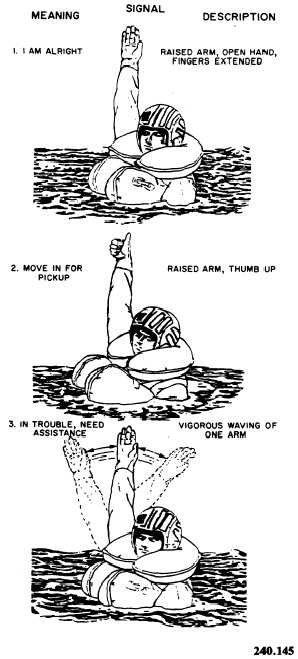available, each liferaft must have an AN/URT-33A beacon or AN/PRC-90 radio set. We will cover the AN/PRT-5, AN/URT-33A, and the AN/PRC-90 survival radios in this chapter.
In addition to the automatic direction finder (ADF) capability of SAR force aircraft, the United States government also uses satellites that monitor guard frequencies for emergency locator transmitter (ELT) broadcasts.
AN/PRT-5. - The AN/PRT-5 radio transmits a tone-modulated signal in both high- and ultrahigh-frequency ranges. The set has an inflatable collar assembly that allows it to float at sea or sit upright on land. The radio can operate continuously for 72 hours at 25C (77F). No provisions for voice or code communications or for receiving signals from search aircraft are available with this transmitter. The AN/PRT-5 radio operates on 243.0 and 8364 MHz. The assembly instructions and the directions for use are included with each set.
AN/URT-33A. - The AN/URT-33A beacon radio is a battery-operated radio that transmits a tone-modulated radio signal. The battery provides 72 hours of continuous operation. It must be pointed out that this beacon should not be used at the same time the AN/PRC-90 is being used, as the AN/URT-33 will inter- fere with the voice communication signal of the AN/PRC-90. When you are using the AN/URT-33, do not point the antenna directly toward the receiving aircraft because of the type of antenna employed; a conical area perpendicular to the antenna tip does not radiate a signal.
Do not attempt to use the telescoping antenna onthe AN/URT-33 A radio without first detaching the flexible antenna. Use of both antennae creates interference in the transmission patterns of both.
To turn the AN/URT-33A radio on, you must move the switch to a position where the word ON can be read. This may be confusing to the aircrewman, and the AN/URT-33A could be on when the aircrewman thinks it's OFF.
AN/PRC-90. - The AN/PRC-90 radio set is a dual-channel personal emergency rescue transceiver, used principally for two-way-voice or modulated-continuous-wave (MCW) communica- tion between a downed aircrew member and a rescue aircraft. Provisions are included for transmitting tone MCW and swept-frequency homing beacon signals to guide rescue efforts.
The AN/PRC-90 is battery powered and contains a flexible antenna, an interchangeable telescopic antenna, a function switch (knob and indicator), an MCW button for Morse code, a volume control dial, and an earphone.
When you are using the voice mode, the AN/PRC-90 is capable of transmitting up to 60 nautical miles (nmi) and up to 80 nmi on beacon or code. A rule of thumb is that this and other survival radios are limited to a line-of-sight

Figure 5-37. - Rescue hand signals.
Continue Reading